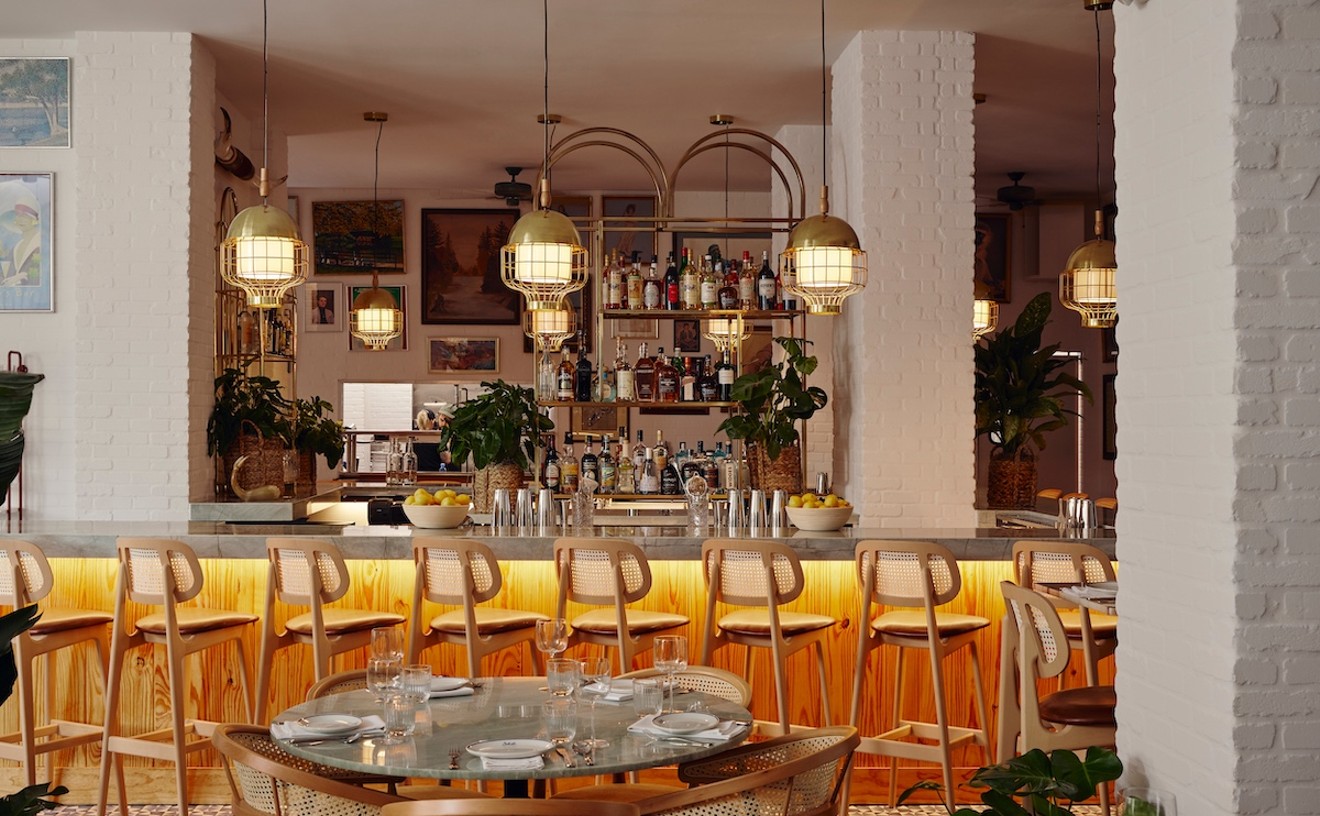A few eateries, like New York's River Café, have made a strength of their revolving young chefs, to the point that they're renowned as star-maker restaurants. Dining at one of these places is an electrifyingly anticipatory experience, just as it must have been to walk into Boston's Club Passim in the Sixties, when the fledgling performers were Bonnie Raitt, or maybe Bob Dylan. Rather than instability, the managers of such places display some magical Midas instinct for sensing unique talent -- you may not know the chef today, but a few years down the road you and everyone else may recognize the name; and diners can feel fairly confident that the food will be original and exciting as well as solidly conceived, skillfully executed, and gracefully served -- not just a flash in the pan.
In Miami, Wish has been one of these reliable rising-star restaurants. Since opening in late 1998, the striking South Beach indoor/outdoor spot has had four young chefs. Aside from age, what all have had in common is a flair for fusion cooking. For first executive chef Gary Robins, the fusion was gourmet and vegetarian. When he fled to fame in New York City after a few months, it was only because South Florida diners weren't ready to believe that cuisine could be sophisticated and fully satisfying sans meat; the food itself was fabulous.
Following Robins, Wish's patterns of fame and fusion continued with Andrea Curto, who now cooks her strongly Italian- and Asian-influenced New American creations at Miami Beach's Talula with spouse Frank Randazzo. Then came E. Michael Reidt, who improbably but wonderfully fused Asian, Brazilian, and classical French influences. Curto and Reidt both ended up gracing the cover of Food & Wine, in 2000 and 2001, part of the magazine's annual list of America's ten best new chefs.
Like Curto and Reidt, Wish's latest chef, Michael Bloise (he took over this past December), cooks a cuisine of the heart, fusion influenced not by trend but by personal family upbringing. Bloise's background, however, isn't quite as straightforward as Curto's Italian-American one. He's half-Italian, half-Vietnamese. Certain items on the menu sound so weird one suspects he may have grown up in South Park.
Did Reidt's bolino de bacalhau (a traditional Brazilian cod cake gone wild with Asian/ French panko crumbs, ginger aioli, and lemon confit) strike you as strange? Wait till you try Bloise's pan-seared foie gras -- two buttery duck-liver lobes sandwiched between cascabel chili-crusted plantain slices and topped with a big black-pepper-sprinkled roasted marshmallow. Yes, former Girl Scouts and Boy Scouts, it was a foie gras s'more. And it worked wonderfully. There is actually a whole new branch of food science, called molecular gastronomy, that explains why: According to a chemical "law of dominance," ingredients with dominant tastes (like very sweet marshmallows) get awakened by ingredients with differently dominant tastes (like very hot chilies). White chocolate and caviar work together too. Go figure.
Or just eat. Less than two minutes after this starter, intended to be shared, had been passed to the normally chili-phobic diner at our table, she looked down at the plate and was astonished. "Sorry," she said. "Gee, I guess I ate it all. It was just so good." The considerable heat had indeed been tamed by the sweet.
Bloise does not go as far out as the Michelin-starred chef in London who combines crab with ice cream. But crème fraîche and sherry vinaigrette did skillfully enrich a Vietnamese-derived crab and pea shoot spring roll. In their traditional Eastern style, these cold and crunchy rice paper-wrapped packets are always refreshing but sometimes stark. The lush Western fusion touches countered all austerity, and a chili kick enlivened the combination of sweet blue crab, veggies, mint, and cilantro.
A "Roaring Forties" salad (named for the Australian cheese that dotted the mix of watercress, apples, and roasted walnuts) was not an unusual combination. Still the firm yet sumptuously creamy texture of the butterlike blue cheese made it unusually good. A fig jam vinaigrette was extremely sweet, but lightly enough applied to avoid overpowering the greens.
Among entrées, crispy-skinned snapper with Vietnamese tea foam was the winner. The grilled shrimp that garnished the dish were a bit bland and had been overcooked, but the snapper was perfectly moist. And its savory skin was addictive, as close as a piscatarian could get to chicharrónes. Do not dread that the foam is overly acidic, or a meringuelike gimmick. The green tea tang was subtle, and balanced by the sweet Chinese sausage chunks in the dish. The texture combined whipped lightness with satisfying richness, like a very airy beurre blanc. No Lipton's. No bubble bath.
The pan-roasted chicken with hot, pepper-crusted cashews, strongly scented with cumin and coriander, was also crisp outside and juicy inside, even the white meat. The bird came with a good but not exciting accompaniment of sweet and green plantains plus Asian long beans. The latter are much like American string beans, just longer and a little meatier. The dish's tangerine-ginger beurre blanc was smooth but so citrusy it was both cloying and bitter. Orange peel actually figured prominently in most items we tried. Even with Bloise's characteristic chili counter, the sameness eventually became boring.
Only a tomato-balsamic-sauced prime grilled ribeye sadly disappointed, but the accompanying wild mushroom/Manchego risotto was sumptuous. The fourteen-ounce steak itself was more than one-third fat. And we're talking inch-wide borders and big interior chunks of fat, not quality prime-meat marbling.
For dessert, it's possible to play it safe with the usual "melting" chocolate cake. But the menu abounds with invitations to finish up with a walk on the wild side: papaya-lime soup, strawberry mousse with basil, or Grand Marnier-spiked carrot cake with ginger cream cheese frosting, accompanied by soy sauce sorbet. This last was tempting, but having overdosed on orange flavorings by then, we opted for "Tony's Delight." The mélange of Asian-flavored marinated fruit salad, watermelon lime sorbet, and avocado mousse was ample for three, and refreshing enough to be an ideal midsummer cooler. It was also a terrific "one dessert, several spoons" compromise for people who can't make up their minds -- though the ice cream-smooth mousse, rendered rich rather than peculiar by the avocado, proved a hit with even the most conservative among us.
With starter and entrée prices averaging, respectively, about $13 and $30, Wish remains expensive even by South Beach standards. But the service is still gracious. The setting is still stylish. The wine list is still intriguing (with some Australian and New Zealand bottles nicely priced around $25). And the fusion food is still savory after all these years.










